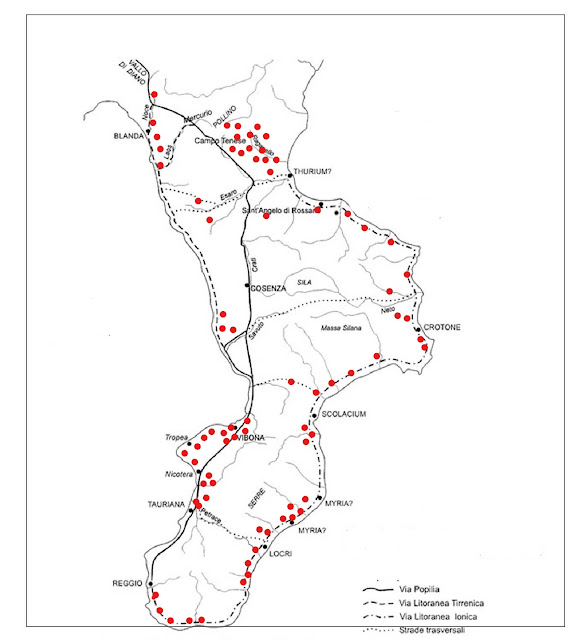Ancient LOCRI
Dear lectors of history, art and calabrian places, in this post brig you in the locride, an area rich in archaeological sites, rest of roman villas....
Let's start from ancient Locri or Locroi
Therefore the city (previous greek polis) appears in smaller forms.
Between I and II century a.C. also Locri will see the construction of great monumental complexes (thermal bath, complex for markets, theater).
roman landscape in late atiquity - The Romans developed the territory around Locri thanks to the its coastal plain very fertile, so between imperial age and late ancient (I-IV century AD) several roman villas were born, but also statio.
Let's start from ancient Locri or Locroi
position of Locri
greek colonists ship
HISTORY - Locri was founded by Greek colonists in the VII b.C. coming from a region called Locride, the first settlement was born on promontory of Capo Bruzzano (figure below).
After a few years the greek colonists moved on another site to founded a new city under the name of Locroi, the place chosen is located to twenty chilometers to north from Capo Bruzzano, in the middle of a vaste and fertile coastal plain.
in red position of Locri in middle of the plain
In a short time it became one of the most prosperous cities of the Magna Grecia and its territory (chora) include also the tyrrhenian coast (figure below).
In II century b.C. the city was conquered by Romans with them the city remained the administrative centre of the low ionic area, but it lost importance and some suburban areas was abandoned.After a few years the greek colonists moved on another site to founded a new city under the name of Locroi, the place chosen is located to twenty chilometers to north from Capo Bruzzano, in the middle of a vaste and fertile coastal plain.
promontory of Capo Bruzzano place of the first greek seattlement.
in purple Capo Bruzzano (first greek seattlement) and in red current position of Locri
in red position of Locri in middle of the plain
The city and the countryside were integrated space, the Greek polis could never disregard agricultural activity, becouse agricolture was the main source of sustenance, land owership was fundamental requisite for enjoying citizenship rights.
In a short time it became one of the most prosperous cities of the Magna Grecia and its territory (chora) include also the tyrrhenian coast (figure below).
in red the borders of the territory (chora) of Locri, on tyrrhenian coast it founds two sub-colonies with the name Hipponion (north) and Medma (souh).
ruins of the ionic temple of Marasà V-IV century b.C.
reconstruction of a column with capital in ionic style.
(by Giorgio Gullini-centroscavitorino.it)
Dioscuri of Marasà temple:
the marble group constituted the sculptural decoration of the western front of the ionic temple sanctuary of contrada Marasà.
(foto by archeoluino.it)
the Magna-greek colonial centre of Locri was remember for pinakes, terracotta votive tablets (V century b.C.)
Depict bas-relief scenes related to the myth of Persephone and the rituals of the cult paid to the goddess at the Mannella shrine.
urban greek plant of Locri: the urban organization of Locri expressed trough the typical greek scheme of main and secondary streets (stenopoi and plateai) that intersect narrow and long blocks.
Therefore the city (previous greek polis) appears in smaller forms.
Between I and II century a.C. also Locri will see the construction of great monumental complexes (thermal bath, complex for markets, theater).
greek-roman theater
reconstruction of the roman theater in Locri
(image by digi-art.it)
roman landscape in late atiquity - The Romans developed the territory around Locri thanks to the its coastal plain very fertile, so between imperial age and late ancient (I-IV century AD) several roman villas were born, but also statio.
CONCLUSION: Locri around to the VII A.D. was abandoned remained only the district of the bishop, while the villaes described above were in use until VI century A.D., but some centuries later their rooms were used as dwelling, artisan areas or to bury the dead.
Panorma of Locri nowadays immersed in the coastal plain
Dott. Giuseppe Lombardo


















Commenti
Posta un commento